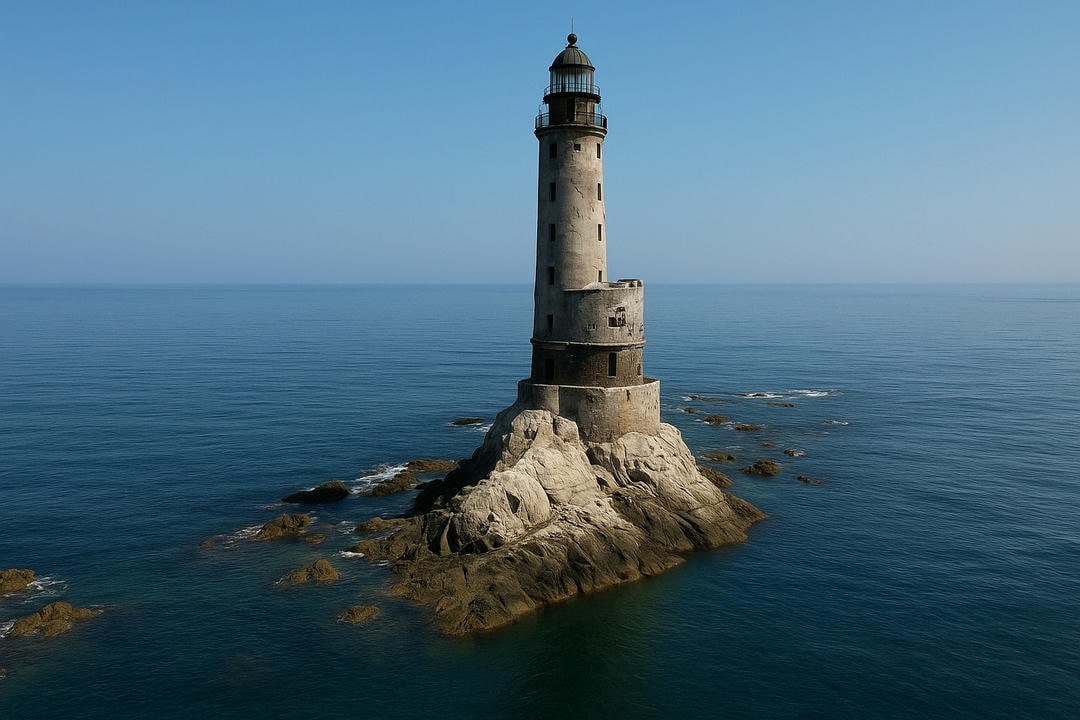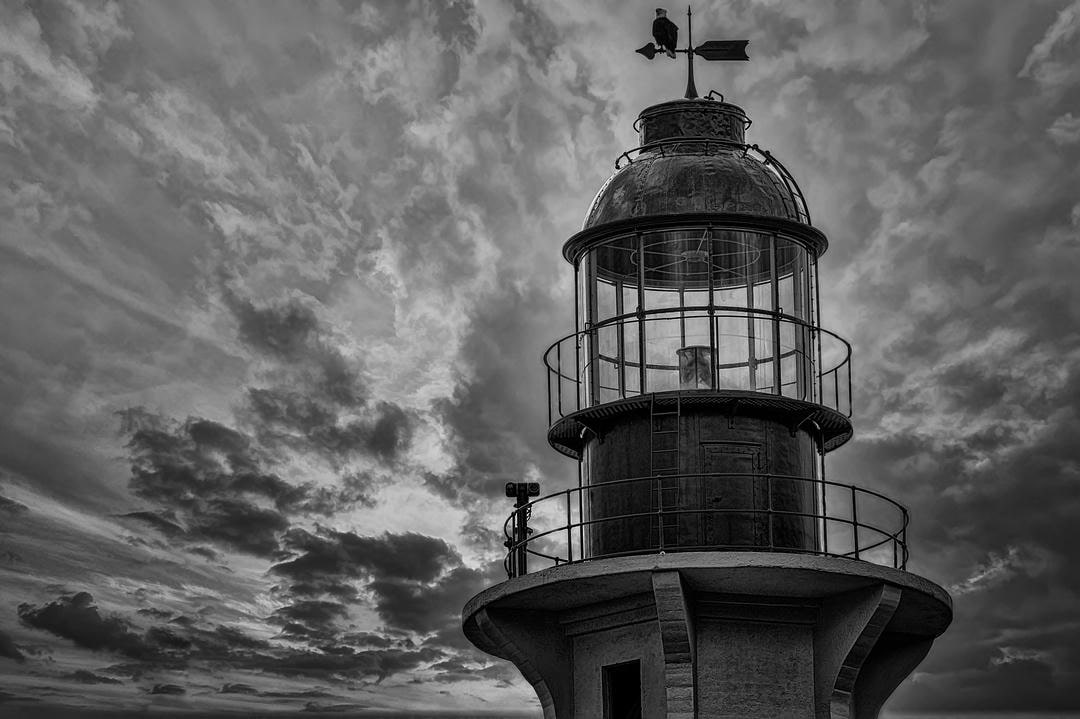Aniva Lighthouse stands as a stark reminder of maritime history and engineering prowess. Erected between 1937 and 1939, it reflects the complex interplay of Japanese and Russian influences. Once a beacon of safety, its abandonment in 2006 has led to significant decay. The lighthouse’s haunting presence raises questions about preservation and the impact of nature on human creations. What does its deteriorating state reveal about resilience and historical narratives?
The Breathtaking Abandoned Aniva Lighthouse

Aniva Lighthouse rises dramatically from a rocky outcrop off southeastern Sakhalin Island, surrounded by the wild beauty of the Sea of Okhotsk. Its remote position, accessible only by boat, emphasizes both its isolation and allure.
Architectural Marvel
Built in 1939 by Japanese engineer Shinobu Miura, the lighthouse was constructed under extremely challenging conditions. Its robust structure once housed a small nuclear reactor, providing autonomous energy for over three decades—a rare feature among lighthouses.
After World War II, the Soviets converted Aniva into a nuclear-powered beacon. The last keeper left in 2010, and since then, the lighthouse has been abandoned. Harsh sea winds and frequent storms have left the structure severely damaged, with experts predicting its collapse within the next decade.
Legends and Mystique
The Aniva Lighthouse carries with it a deep sense of isolation and haunting beauty. Its remote location, surrounded by the relentless sea and wild weather, has made it a magnet for stories that blend history with the supernatural. Over the years, the lighthouse’s stark silhouette against the often turbulent sky has inspired numerous legends, solidifying its place as a symbol of maritime mystery and cultural fascination.
Local lore tells of ghostly apparitions appearing within the lighthouse, believed to be the spirits of former keepers who perished while tending to their duties under harsh conditions. Fishermen and sailors navigating nearby waters have reported eerie lights flickering in the lighthouse windows during stormy nights, long after it was decommissioned. Some say these lights serve as warnings or even guides to lost souls at sea.
Another popular legend speaks of a tragic love story tied to the lighthouse keepers — a tale of separation and devotion that transcends time and death, adding a layer of romantic melancholy to the site’s mystique. Visitors and explorers drawn to Aniva often recount feelings of an unseen presence or strange sounds carried by the wind, enhancing the eerie atmosphere.
The combination of its architectural grandeur, natural isolation, and these enduring stories has made Aniva Lighthouse more than just a navigational aid; it stands as a cultural landmark steeped in mystery. The legends surrounding it continue to attract photographers, ghost hunters, and history enthusiasts eager to experience firsthand the enigmatic aura that surrounds this maritime sentinel.
Symbolism and Heritage
Aniva Lighthouse stands as a testament to maritime heritage, symbolizing human perseverance against nature’s fury. Its presence reflects the historical significance of navigational technology and its vital role in ensuring safe passage through treacherous waters.
Tourism and Preservation
Despite its deteriorating condition, Aniva Lighthouse attracts adventurous travelers and photographers, drawn by its dramatic setting and the interplay of light and shadow. As interest in eco-tourism grows, the lighthouse offers a unique opportunity to connect with both natural beauty and history. Preservation efforts are limited, and its future remains uncertain as the sea slowly reclaims this iconic sentinel.
The Strategic Importance of Cape Aniva

Cape Aniva, though rugged and seemingly desolate, occupies a vital position at the crossroads of key maritime routes in the Sea of Okhotsk. Historically, these routes enabled trade and economic exchange, making control over them crucial for regional power. Despite advances in navigation, harsh weather and environmental challenges continue to threaten maritime safety, maintaining Cape Aniva’s role as a critical maritime sentinel.
Geography of Sakhalin Island
Sakhalin Island lies between the Sea of Okhotsk and the Russian Far East, featuring diverse volcanic and sedimentary geology shaped by natural forces. Its climate supports rich marine biodiversity essential to local fisheries. Historically a hub for trade, the island’s geography and ecosystems remain central to its cultural and economic identity.
Navigational Hazards and Safety
The waters around Sakhalin and the Sea of Okhotsk are notoriously dangerous, with strong currents, sudden storms, and seasonal ice posing serious risks. Effective navigation aids, such as the Aniva Lighthouse and the Aniva Bay Vessel Traffic Service, are critical for safe passage. These systems regulate vessel traffic, provide communication, and enhance maritime safety amid challenging environmental conditions, underscoring their ongoing importance in this remote region.
Japanese Origins and Influence
The Aniva Lighthouse, built during Japan’s control of southern Sakhalin before World War II, represents a landmark achievement in early 20th-century Japanese maritime engineering. It combined practical design with striking aesthetics, symbolizing resilience and safety amid the region’s harsh seas. This period shaped the area’s geopolitical and cultural landscape, with Japanese influence deeply affecting local society and maritime strategy.
Shinobu Miura’s Design
Architect Shinobu Miura crafted the lighthouse to withstand severe maritime conditions, blending functionality with elegant form. His design addressed challenges like seismic activity and turbulent seas, drawing on historical architectural styles. Careful maintenance ensured the lighthouse’s durability, balancing human ingenuity with nature’s power.
Construction Challenges (1937–1939)
Building the lighthouse was a daunting task. Remote location and harsh weather delayed progress, while sourcing durable materials and skilled labor added complexity. Despite these obstacles, innovative engineering—such as reinforced concrete and streamlined structures—enabled the project’s success, creating a lasting symbol of human determination against nature’s forces.
Striking Architecture
Aniva Lighthouse rises from Sivuchya Rock, standing 31 meters tall with its light reaching 40 meters above sea level. Its cylindrical, multi-story design—crafted by Japanese engineer Shinobu Miura in 1939—blends functionality with resilience, built to endure fierce currents, storms, and fog that once made these waters treacherous for ships.
Interior Layout
Inside, the lighthouse was ingeniously organized: diesel engines and batteries filled the basement, while the kitchen, food storage, radio, and equipment rooms occupied the lower floors. Living quarters for up to 12 keepers spanned the third to fifth floors, with storage, siren mechanisms, and fuel above. The ninth and top floor housed the rotating lens mechanism, which floated on a bowl of mercury and required rewinding every three hours.
Keeper’s Life
Life inside Aniva Lighthouse was defined by solitude and discipline. Keepers maintained the beacon, performed repairs, and faced isolation with limited contact to the outside world. Supplies were difficult to deliver, and harsh weather often intensified the sense of remoteness. Despite these challenges, the keepers’ role was vital for maritime safety, embodying resilience and dedication.
Advanced Technology
Aniva featured a powerful lens system, visible up to 28 kilometers, and was later converted to autonomous operation with a nuclear battery in the 1990s. This allowed the lighthouse to function without a permanent crew until its abandonment in 2010, when advances in satellite navigation made it obsolete.
Preservation and Legacy
Now abandoned and battered by wind and sea, Aniva Lighthouse stands as a haunting monument to maritime history. While restoration efforts have stalled, it remains a popular—if perilous—destination for adventurous travelers, symbolizing human ingenuity and the enduring quest for safety amid nature’s extremes.
Soviet Era and Atomic Power
After World War II, the Aniva Lighthouse—originally built by Japanese engineers between 1937 and 1939—came under Soviet control as part of the USSR’s annexation of southern Sakhalin. This strategic handover reflected broader postwar shifts in regional power and maritime governance, with the lighthouse’s new status symbolizing the assertion of Soviet influence in the Far East.
Technological Transformation
The Soviets modernized the lighthouse, first replacing its acetylene lamp with electric lighting and installing a mechanical rotation system. However, the remote location and harsh conditions made maintenance difficult, often requiring arduous supply runs and constant repairs.
In 1990, the Aniva Lighthouse entered a new era as one of 132 Soviet lighthouses equipped with a radioisotope thermoelectric generator powered by Strontium-90. This nuclear battery enabled autonomous operation for up to a decade without refueling, showcasing the Soviet commitment to harnessing atomic energy for civilian infrastructure—even in the most isolated outposts.
Symbolism and Cold War Context
During the Cold War, the lighthouse stood not just as a navigational aid but as a symbol of technological prowess and national security. Its powerful beam, visible up to 35 kilometers, watched over strategic waters, reflecting the era’s intertwining of scientific progress, ideological rivalry, and the assertion of sovereignty in contested maritime regions.
Decline and Legacy
By 2006, with the advent of satellite navigation and the depletion of its nuclear battery, the Aniva Lighthouse was decommissioned and left to the elements. Today, it stands abandoned—its structure battered by wind and sea—but remains a magnet for adventurous travelers and a testament to the ambitions, innovations, and shifting powers of the 20th century.
Enduring Significance
The Aniva Lighthouse’s evolution—from a Japanese engineering feat to a Soviet atomic sentinel—mirrors the broader story of technological adaptation and geopolitical change in Eastern Asia. Its current state of decay underscores the challenges of preserving such remote monuments, even as they continue to captivate with their history and haunting beauty.
Abandonment and Decay
Once a vital beacon guiding ships through the perilous waters off Sakhalin, the Aniva Lighthouse now stands as a haunting relic, battered by relentless weather and neglect. Its isolated perch on Cape Aniva, surrounded by treacherous currents and frequent fog, made it essential for maritime safety—but also nearly impossible to maintain. Today, the lighthouse’s concrete tower still rises defiantly, though rusting metalwork and crumbling brick reveal the toll of decades without upkeep.
Reasons for Abandonment in 2006
The lighthouse was abandoned in 2006, a casualty of both technological progress and economic realities. Advances in satellite navigation and modern maritime systems rendered traditional beacons obsolete, while the end of its nuclear battery’s lifespan eliminated the last practical means of autonomous operation. With dwindling funding and little strategic need, authorities ceased maintenance, leaving the structure to the elements.
Current Condition and Safety
Despite its decay, the Aniva Lighthouse remains a magnet for adventurous travelers, drawn by its dramatic setting and storied past. Reaching the site is an ordeal—requiring a long journey by road, boat, and even climbing over rocks—but visitors are rewarded with breathtaking views and a sense of awe at the structure’s endurance. However, safety is a growing concern: the building’s interior is deteriorating, with rusted metal, unstable floors, and exposure to the harsh marine environment making exploration increasingly hazardous. Experts warn that, without intervention, the lighthouse may soon become too dangerous to visit.
Preservation Challenges
Efforts to restore or preserve the lighthouse have been sporadic, hampered by its remote location and the logistical complexities of transporting materials and personnel. While some local enthusiasts advocate for its conservation as a cultural landmark, limited resources and minimal community involvement have stymied large-scale initiatives. The structure’s future is uncertain, with ongoing erosion and storm damage threatening its survival.
A Symbol of Transience
The Aniva Lighthouse’s slow decline is more than a tale of physical decay—it is a powerful metaphor for the impermanence of human achievement. Once a triumph of engineering and international ambition, it now stands as a stark reminder of nature’s dominance and the fleeting relevance of even the grandest projects.
Enduring Legacy
Though its light no longer guides ships, the Aniva Lighthouse endures as a monument to history, resilience, and the inexorable passage of time. Its fate hangs in the balance, poised between total ruin and the hope of preservation. Whether reclaimed by the sea or saved for future generations, its story continues to inspire those who seek out its windswept solitude—a testament to both the fragility and the enduring allure of humanity’s maritime heritage.





